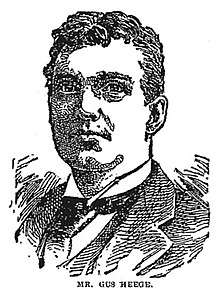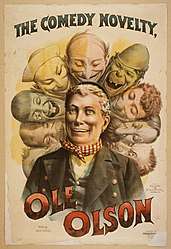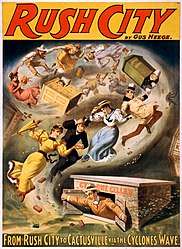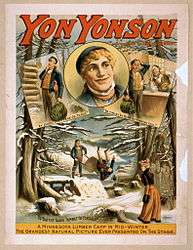Gus Heege
Augustus J. "Gus" Heege (1862 – February 2, 1898) was an American playwright and actor, whose works were popular at the end of the 19th century.[1]
 | |
| Born | Augustus J. Heege 1862 Cleveland, Ohio, U.S. |
| Died | February 2, 1898 (aged 36) Cleveland, Ohio, U.S. |
| Occupation | Playwright, actor |
| Spouse(s) | Mary Lillian "Lilly" Mandeville |
| Children | 1 |
Early life
A native of Cleveland, Ohio, Gus Heege was the son of a prominent member of the city's police department.[1] He attended the district school in nearby Brecksville where he entertained his fellow students with all manner of performances, giving an early indication of his acting talents.[3] Soon after graduating from Cleveland's Central High School, he headed East to seek his fortune on the New York stage.[1]
Career
A talented actor, Heege often took the leading role in his productions. Although his output was varied, he is largely remembered for the Swedish immigrant trilogy, Ole Olson (1889), Yon Yonson (1890) and Yenuine Yentleman (1895). These plays established the character of the comic Swedish immigrant in American theater.[1]
Heege, who was of German ancestry, maintained that careful observation of the newcomers had enabled him to faithfully portray them on stage.[1] A newspaper account told of his field research in the "Little Scandinavia" of northern Wisconsin, where large numbers of Swedes, Norwegians and Danes had settled.[4]
Not everyone found his characters believable. In reviewing Yon Yonson a critic wrote: "The hero is a Swede who speaks English with Scandinavian dialect, the accuracy of which is vouched for by Mr. William M. Dunlevy, the enterprising manager of the Park Theatre, and Mr. Jacob Litt, the manager of this particular play, who are old log-rollers themselves. We are quite willing to accept their word for it, especially as no man would be likely to invent such a dialect. But the Swedes and Norwegians we have in the East do not speak English in the Yon Yonson way."[5]
The author Willa Cather gave a decidedly negative review to Heege's Rush City in the Nebraska State Journal while conceding that Yon Yonson had been a "very good comedy".[6] In 1931 Cather wrote that before 1913, when her novel O Pioneers! was published,[6] "the Swede had never appeared on the printed page in this country except in broadly humorous sketches; and the humor was based on two peculiarities: his physical strength and his inability to pronounce the letter 'J'".[7]
Ben Hendricks (1868-1930) was the actor most associated with Heege's Scandinavian dialect plays. He starred in all three of them and toured with revivals of Ole Olson until 1912, over twenty years after the play's opening.[1]
Later years
In time Heege's portrayal of Swedish immigrants found both popular and critical acceptance.[1] Heege died at his home in Cleveland on February 2, 1898, of kidney disease.
After the playwright's death, the American Dramatists' Club passed the following resolution: "That in his demise the stage has been deprived of one of its truest dialectic disciples, an actor of refined quality, a pronounced genius in the depiction of Swedish and Scandinavian character, and a cheerful, charitable spirit."[8]
Gus Heege's final work, Amalia Mora, was a Swedish-American opera that premiered in 1901.[9][10] His son, Philip, also became a Broadway actor.[11][12]
Selected works
- Wanted: The Earth 1887
- Criss Cross 1888
- Sky Skraper 1888
- Ole Olson 1889
- Yon Yonson 1890
- Rush City 1893
- Yenuine Yentleman 1895
- Amalia Mora 1901
See also
Gallery
 1890 poster for Ole Olson
1890 poster for Ole Olson 1894 poster for Rush City
1894 poster for Rush City 1899 poster for Yon Yonson
1899 poster for Yon Yonson
References
- Theatre History Studies edited by Rhona Justice-Malloy, (Tuscaloosa, Alabama: University of Alabama Press, 2008). Volume 28, pp. 71 - 82 .
- Phyllis A. Whitney phyllisawhitney.com. Retrieved June 06, 2015.
- A History of Cuyahoga County and the City of Cleveland by William R. Coates, (Chicago: The American Historical Society, 1924).
- New York Times January 28, 1895.
- New York Times December 29, 1891.
- The Willa Cather Archive cather.unl.edu. Retrieved June 06, 2015.
- Willa Cather on writing: critical studies on writing as an art by Willa Cather, (Lincoln: University of Nebraska Press, 1988).
- New York Dramatic Mirror February 12, 1898.
- New York Dramatic Mirror August 24, 1901.
- "Amalia Mora" by Gus Heege and Max Faetkenheuer www.loc.gov. Retrieved June 6, 2015.
- "Yon Yonson" Broadway Revival ovrtur.com. Retrieved June 06, 2015.
- Philip Heege ibdb.com. Retrieved June 06, 2015.
External links
| Wikimedia Commons has media related to Gus Heege. |
Article
Reviews
- Yon Yonson in the New York Times (December 29, 1891)
- Rush City in the New York Times (April 17, 1894)
- Willa Cather on Rush City in the Nebraska State Journal (October 14, 1894)
- Amalia Mora in the New York Dramatic Mirror (August 24, 1901)
Obituaries
- "Death Of Gus Heege" in the New York Times ( February 3, 1898)
- "The Death Of Gus Heege" in the New York Dramatic Mirror (February 12, 1898)
- "Death of Original Ole" in the Hawaiian Gazette (March 11, 1898)
Streaming audio at the Internet Archive